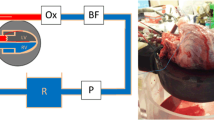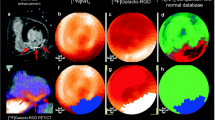Abstract
Purpose
The purpose of this study is to follow myocardial angiogenesis temporally using quantitative magnetic resonance first pass perfusion imaging and compare this with the “gold standard“ of radioactive microspheres in a random subset of animals.
Materials and Methods
Ameriod constrictors where placed around the left circumflex in 15 pigs to induce an ischemic area. Two groups were randomized to receive either a sham operation or treatment with angiogenic implants inserted into myocardium in the distribution of the left circumflex artery (LCX). These implants are designed to induce myocardial angiogenesis. Magnetic resonance first pass perfusion imaging was performed at baseline and also after treatment with either sham or implant therapy by using first pass perfusion imaging with a TurboFLASH sequence. Absolute myocardial blood flow was derived by applying a quantitative Fermi function model. Radioactive microspheres were also injected into a random subset of animals to measure myocardial blood flow.
Results
Angiogenic implant therapy increased absolute myocardial blood flow in the left circumflex territory relative to baseline and sham treated groups during adenosine infusion. Myocardial blood flows measured with radioactive microspheres was increased significantly in both the LCX and LAD territories during stress. Myocardial Perfusion reserve was also significantly increased in both the LCX and left anterior descending territories relative to baseline. Ejection Fraction during stress with dobutamine infusion increased significantly in the implant therapy group while that in the sham group was not affected.
Conclusion
Quantitative MR myocardial first pass perfusion imaging can be used to track the development of angiogenesis as corroborated by radioactive microspheres. Angiogenic implant therapy is a new device based therapy that has potential to protect an ischemic region by accelerating angiogenesis although further research is necessary with this device.
Similar content being viewed by others
References
Yang EH, Barsness GW, Gersh BJ et al (2004) Current and future treatment strategies for refractory angina. Mayo Clin Proc 79(10):1284–1292
Wilke NM, Zenovich A, Muehling O, Jerosch-Herold ML (2000) Novel revascularization therapies—TMLR and growth factor-induced angiogenesis monitored with cardiac MRI. MAGMA 11:61–64
Jerosch-Herold M, Muehling OM, Zenovich A et al (2000) MRI perfusion measurements of myocardial angiogenesis following pericardial delivery of VEGF. Proc Annual Scientific Sessions of the ISMRM 440
Hendel RC, Henry TD, Rocha-Singh K et al (2000) Effect of Intracoronary recombinant human vascular endothelial growth factor on myocardial perfusion. Evidence for a dosedependent effect. Circulation 101:118–121
Nikolic SD, Eichstaedt H, Eya K et al (2000) New angiogenic implant therapy improves the function of the ischemic ventricle. Circulation 102:II–689
Lima JAC (1998) Diagnostic imaging in clinical cardiology. UK, Murtin Dunitz Publishing, pp. 1–25
Van der Wall EE, Blanksma PK, Niemeyer MG et al (1998) Advanced imaging in coronary artery disease. Boston, Kluwer Academic Publishing, pp. 53–69, 67–99
Higging CB, Ingewall JS, Pohost GM (1998) Current and future applications of magnetic resonance in cardiovascular disease. Armonk, NY, Futura Publishing Company, pp. 197–321
Wilke NM, Zenovich AG, Jerosch-Herold M, Henry TD (2001) Cardiac magnetic resonance imaging for the assessment of myocardial angiogensis. Curr Interv Cariol Rep 3:247–256
Lewis BL, Flugelman MY, Weisz A et al (1997) Angiogenesis by gene therapy: a new horizon for myocardial revascularizations? Cardiovasc Res 35:490–497
Wilke NM, Jerosch Herold M (1998) Assessing myocardial perfusion in coronary artery disease with magnetic resonance first-pass imaging. Cardiol Clin 16:227–246
Stillman AE, Wilke N, Jerosch-Herold M (1999) Myocardial viability. Radiol Clin North Am 37:361–378
Jerosch-Herold M, Wilke N, Stillman AE (1998) Magentice Resonance quantification of the myocardial␣perfusion reserve with a Fermi function model␣for constrained deconvolution. Med Phys 25:73–84
Wilke NM, Jerosch-Herold M, Zenovich A, Stillman AE (1999) Magnetic resonance first-pass myocardial perfusion: clinical validation and future applications. J␣Magn Reson Imaging 10:676–685
Author information
Authors and Affiliations
Corresponding author
Rights and permissions
About this article
Cite this article
Panse, P., Klassen, C., Panse, N. et al. Magnetic resonance quantitative myocardial perfusion reserve demonstrates improved myocardial blood flow after angiogenic implant therapy. Int J Cardiovasc Imaging 23, 217–224 (2007). https://doi.org/10.1007/s10554-006-9105-8
Received:
Accepted:
Published:
Issue Date:
DOI: https://doi.org/10.1007/s10554-006-9105-8




